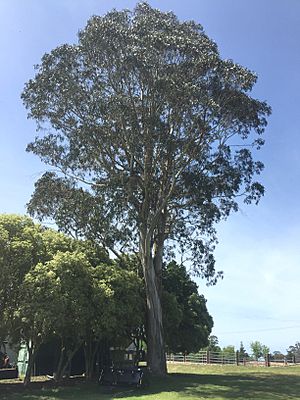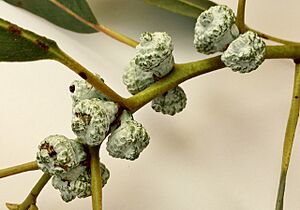Victorian blue gum facts for kids
Quick facts for kids Victorian blue gum |
|
|---|---|
 |
|
| Subspecies bicostata at Moss Vale | |
| Scientific classification |
|
| Kingdom: | Plantae |
| Clade: | Tracheophytes |
| Clade: | Angiosperms |
| Clade: | Eudicots |
| Clade: | Rosids |
| Order: | Myrtales |
| Family: | Myrtaceae |
| Genus: | Eucalyptus |
| Species: | |
| Subspecies: |
E. g. subsp. bicostata
|
| Trinomial name | |
| Eucalyptus globulus subsp. bicostata (Maiden, Blakely & Simmonds) J.B.Kirkp.
|
|
| Synonyms | |
|
|
The Southern Blue Gum, also known as Eurabbie or Victorian Blue Gum, is a type of tree. Its scientific name is Eucalyptus globulus subsp. bicostata. This tree is special because it is endemic to south-eastern Australia. This means it naturally grows only in that part of the world.
This blue gum tree has bark that is mostly smooth. It also has young leaves that are shiny on one side and a bit waxy on the other. Its adult leaves are long and glossy. The tree produces flower buds that grow in groups of three. These buds are warty and open into white flowers. After flowering, it grows fruit that looks like a small, woody cup.
Contents
What Does the Southern Blue Gum Look Like?
The Southern Blue Gum is a tall tree that can grow up to 45 meters (about 148 feet) high. It has a special woody swelling at its base called a lignotuber. This helps the tree regrow if it gets damaged, for example, by a bushfire.
Bark and Leaves
The bark of this tree is usually smooth. It peels off in long strips, leaving the trunk looking white or grey. Sometimes, you might see rough bark at the bottom of the trunk.
Young plants have stems that are somewhat square-shaped. They have small 'wings' on each corner. Their young leaves grow in pairs and are oval-shaped. The underside of these leaves has a white, waxy coating. They are about 40 to 115 millimeters (1.6 to 4.5 inches) long.
Adult leaves are shiny green and shaped like a spear. They are much longer, from 140 to 400 millimeters (5.5 to 15.7 inches) long. These leaves grow on a stalk called a petiole, which is about 30 to 60 millimeters (1.2 to 2.4 inches) long.
Flowers and Fruit
The flowers of the Southern Blue Gum grow in groups of three. These groups appear in the axils (the angle between a leaf and the stem). Each group sits on a thick stalk called a peduncle.
The flower buds are warty and shaped like a cone. They are about 10 to 18 millimeters (0.4 to 0.7 inches) long. These buds have two small ridges along their sides. The top part of the bud, called the operculum, is flat with a small knob in the middle.
Most of the flowering happens between January and March. The flowers are white. After the flowers, the tree produces woody fruit. This fruit is shaped like a half-sphere or a cone. It is about 7 to 10 millimeters (0.3 to 0.4 inches) long and has two ridges along its sides.
Where Does the Southern Blue Gum Grow?
The Southern Blue Gum grows in open forests. You can find it in mountainous areas, mostly inland, in New South Wales and Victoria. It grows from the Carrai National Park in New South Wales down to the eastern ranges of Victoria.
Gallery









